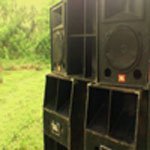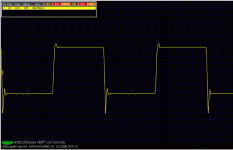Re: OPA134 Issue
I'm not sure if this is related but here are my symptoms.
I started the preliminary tests last night, but was surprised to find 0v for the bias. Adjusting the pot has no effect. I have voltage at the zeners, 14.57/-14.57. I put my new scope on the OPA123 ouput and I have an 8v p-p sawtooth at roughly 1.8Mhz.
Any suggestions on how I can proceed to debug this baby ?
Thanks,
Argo
P.S. I have 4 boards with the same symptoms!
ACD said:
This is just a notice that there may be a capacitance issue using the OPA134 opamp in the LYNX amp.
I'm not sure if this is related but here are my symptoms.
I started the preliminary tests last night, but was surprised to find 0v for the bias. Adjusting the pot has no effect. I have voltage at the zeners, 14.57/-14.57. I put my new scope on the OPA123 ouput and I have an 8v p-p sawtooth at roughly 1.8Mhz.
Any suggestions on how I can proceed to debug this baby ?
Thanks,
Argo
P.S. I have 4 boards with the same symptoms!
Sorry but I have never heart about OPA123, so I assume you mean OPA132......
Could be related to the same problem, as the OPA132 is a 8 MHz BW opamp.....
As expected these high speed opamps are extreme sensitive to radiated noise through supply wires and direct from the air.......
May be the reason, but I didn't had the time yet to do further experiments though.
Could be related to the same problem, as the OPA132 is a 8 MHz BW opamp.....
As expected these high speed opamps are extreme sensitive to radiated noise through supply wires and direct from the air.......
May be the reason, but I didn't had the time yet to do further experiments though.
Duh !
Sorry about the confusion
What I actually meant to say was OPA134.
I've been using many OPA2134's lately.
I guess the keyboard to brain interface malfunctioned since I'm not fully awake yet. 😉
Sorry about the confusion
What I actually meant to say was OPA134.
I've been using many OPA2134's lately.
I guess the keyboard to brain interface malfunctioned since I'm not fully awake yet. 😉
Bias problem.
Before I spend $100 on 4 x OPA627's would the 0v DC bias that I currently measure be related to the op-amp oscillations ? The sawtooth is present at tpA and tpC, although a little attenuated and distorted.
Thanks again.
Before I spend $100 on 4 x OPA627's would the 0v DC bias that I currently measure be related to the op-amp oscillations ? The sawtooth is present at tpA and tpC, although a little attenuated and distorted.
Thanks again.
Try first with a slow opamp and see what happens. If it still oscillate then carefully go through your wiring.
New Member
Hello.... Friend Jan Dupont... And Also The Members Of The
diyAudio Im Very Interesting To Building A Power Amp Like Lynx
Power Amp And Krell Clone Can You Teach Me...
🙂 🙂 🙂 Sorry For My Bad English...
Hello.... Friend Jan Dupont... And Also The Members Of The
diyAudio Im Very Interesting To Building A Power Amp Like Lynx
Power Amp And Krell Clone Can You Teach Me...
🙂 🙂 🙂 Sorry For My Bad English...
What do you want to know ?Im Very Interesting To Building A Power Amp Like Lynx
Power Amp And Krell Clone Can You Teach Me...
The LYNX and the Krell is far apart in design, so you must first define what kind of amp you want, and then we can see at the what type will suit you 😉
PSU...
Hello.. Jan If I Used A Low Impedance Speaker ... Why The Supply Rail Going Down.... Maybe I Used 600VA 50V-0-50V for The Low Impedance 4ohm....
Hello.. Jan If I Used A Low Impedance Speaker ... Why The Supply Rail Going Down.... Maybe I Used 600VA 50V-0-50V for The Low Impedance 4ohm....
Good Evening Jan....
I Assembly A Lynx Power Amp One Channel Only
But I Can't Yet Test It Bcoz I Don't Know The Rail
Voltage Can I Used To Drive A Low Impedance Speaker
For My 18inc Sub...... What PSU For Low Impedance At 40hm?
I Assembly A Lynx Power Amp One Channel Only
But I Can't Yet Test It Bcoz I Don't Know The Rail
Voltage Can I Used To Drive A Low Impedance Speaker
For My 18inc Sub...... What PSU For Low Impedance At 40hm?
EMX_125;
Think of your speaker as an resistor (either 8 Ohm or as your woofer 4 Ohm). Ohms law tells you the math 😉
The lower the resistance (load) is, the lower Rail Voltages are needed to produce the same Watts (Voltage*Current makes the Watts)......
If you want to benefitt of the 50 Volts DC into a 4 Ohm load, the amp must be able to deliver 50/4=12.5A. Take a look at the SOA curve for the MJE21193/21194 output devices. At 50 Volts their SOA limit is app. 2A each. Four output devices *2= 8A, which means you will need at least 3 extra output devices per Rail to benefit from the 50 Volt supply.
You can use your 50-0-50 Volt supply but you have to limit the output to 2A per device in the protection circuit, otherwise you will risk to blow your amp up one day, when turning the Volume to much up.
Note that this 2A per device restriction will allow you to get app. 125W into 4 Ohm.
Think of your speaker as an resistor (either 8 Ohm or as your woofer 4 Ohm). Ohms law tells you the math 😉
The lower the resistance (load) is, the lower Rail Voltages are needed to produce the same Watts (Voltage*Current makes the Watts)......
If you want to benefitt of the 50 Volts DC into a 4 Ohm load, the amp must be able to deliver 50/4=12.5A. Take a look at the SOA curve for the MJE21193/21194 output devices. At 50 Volts their SOA limit is app. 2A each. Four output devices *2= 8A, which means you will need at least 3 extra output devices per Rail to benefit from the 50 Volt supply.
You can use your 50-0-50 Volt supply but you have to limit the output to 2A per device in the protection circuit, otherwise you will risk to blow your amp up one day, when turning the Volume to much up.
Note that this 2A per device restriction will allow you to get app. 125W into 4 Ohm.
Lynx Power Amp...
Jan.... I Used A 2 Pair Of MJE21193/94 Output Devices To Benefit
To 50VDC Supply Rail Into 4 Ohm Load You Means I Add A 3 Extra Output Device? However .... 50VDC Rail Voltage So What The VA Of The Transformer? How Can I Do This Amp To Improve A 400 Watts Into 4 Ohm Load? 😕 😕
Jan.... I Used A 2 Pair Of MJE21193/94 Output Devices To Benefit
To 50VDC Supply Rail Into 4 Ohm Load You Means I Add A 3 Extra Output Device? However .... 50VDC Rail Voltage So What The VA Of The Transformer? How Can I Do This Amp To Improve A 400 Watts Into 4 Ohm Load? 😕 😕
EMX_125;
To get 400W into your woofers you need Rail Voltages of app. +/-58 to 60 Volt DC and 6 pairs of output devices per channel.
To get 400W into your woofers you need Rail Voltages of app. +/-58 to 60 Volt DC and 6 pairs of output devices per channel.
EMX_125;
Worst case; 60V/4R=15A > 60V*15A=900W
So anything from 625W and up for the transformer should do the trick. For the big PSU caps, use at least 2.000uF per output A.
In your case no less than 2x30.000uF per channel.
Worst case; 60V/4R=15A > 60V*15A=900W
So anything from 625W and up for the transformer should do the trick. For the big PSU caps, use at least 2.000uF per output A.
In your case no less than 2x30.000uF per channel.
It's official, the Lynx doesn't like OPA134's
I took the plunge and ordered 4 OPA627's.
I swapped them in and everything is beautiful. Oscillations disappeared, and I was able to set the bias voltage.
Can someone explain however what is meant by "a slow op-amp" ?
I look at the spec sheets and see a gain-bandwidth product of 16Mhz for the OPA627 and 8Mhz for the OPA134. Does the higher number mean a slower op-amp ?
Thanks
P.S. Power transistors going in tonight, I can't wait to hear these babies rock !
ACD said:Try first with a slow opamp and see what happens. If it still oscillate then carefully go through your wiring.
I took the plunge and ordered 4 OPA627's.
I swapped them in and everything is beautiful. Oscillations disappeared, and I was able to set the bias voltage.
Can someone explain however what is meant by "a slow op-amp" ?
I look at the spec sheets and see a gain-bandwidth product of 16Mhz for the OPA627 and 8Mhz for the OPA134. Does the higher number mean a slower op-amp ?
Thanks
P.S. Power transistors going in tonight, I can't wait to hear these babies rock !
argofanatic;
Glad you got your oscillation problems solved 🙂
However this makes it a bit more a mystery 😕
A slow opamp is in the range of 1-2 MHz (in my terms), so solving the oscillation problem by using an even faster opamp is quite interesting......
I will some day try some other opamps with similar specs as the OPA134 to see if the problem is opamp based (OPA134) or has something to do with the bandwith of the used opamps.
Glad you got your oscillation problems solved 🙂
However this makes it a bit more a mystery 😕
A slow opamp is in the range of 1-2 MHz (in my terms), so solving the oscillation problem by using an even faster opamp is quite interesting......
I will some day try some other opamps with similar specs as the OPA134 to see if the problem is opamp based (OPA134) or has something to do with the bandwith of the used opamps.
Hi Jan,
OPA134 and 627 have different shape of open-loop amplitude response, and they differ in phase margin. Depending on application, the faster OPA627 is sometimes more stable than the slower OPA134. BUT, it really depends on the application. Especially in case of more complex feedback circuit, with active devices in the loop, the replacements have to be verified carefully.
Cheers,
Pavel
OPA134 and 627 have different shape of open-loop amplitude response, and they differ in phase margin. Depending on application, the faster OPA627 is sometimes more stable than the slower OPA134. BUT, it really depends on the application. Especially in case of more complex feedback circuit, with active devices in the loop, the replacements have to be verified carefully.
Cheers,
Pavel
Thanks Pavel 😉
I know the difference in shape of open-loop amplitude respons (thanks for posting the image of the OPA134 respons) , but what puzzels me most is that the OPA134 works perfectly on some LYNXs' and not on others.
Seems like a very carefully component selection is needed for running the LYNX with the OPA134. I must be lucky to have select the right components to my LYNX amps from the very beginning......
I know the difference in shape of open-loop amplitude respons (thanks for posting the image of the OPA134 respons) , but what puzzels me most is that the OPA134 works perfectly on some LYNXs' and not on others.
Seems like a very carefully component selection is needed for running the LYNX with the OPA134. I must be lucky to have select the right components to my LYNX amps from the very beginning......
- Status
- Not open for further replies.
- Home
- Amplifiers
- Solid State
- Official LYNX Power Amp builder’s thread

